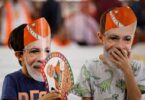NEW DELHI (Dailymail): Chilling footage has emerged of Covid patients left to die on a hospital ward in India from lack of oxygen as victims’ relatives say they were ‘abandoned’ by doctors.
The tragic scene unfolded at Kriti Hospital, a private clinic near New Delhi, on Friday last week around 9pm after families of the Covid patients were told that oxygen supplies were running low.
Relatives – who had been paying up to £1,000 per day for a bed – said they rushed to the hospital but found it deserted and the ICU ward locked, only to find their relatives had died when the doors were finally opened.
Police then had to be called to ‘deescalate’ the situation when families found medical staff hiding in the canteen, and threatened to attack them.
As video of the tragedy went viral on Wednesday this week, officers said the facility was not authorised to treat Covid patients and an investigation is underway.
It is just the latest shocking scene to emerge from India, which is suffering the world’s worst second wave of Covid with another 412,262 cases reported today and 3,980 new deaths – both record figures.
The Kriti Hospital has 50 beds for Covid patients and, according to doctors, those that died were between the ages of 40 and 80.
The hospital administration confirmed the doctors and staff members were temporarily ‘hiding’.
A spokesperson said: ‘In a fear of losing their lives, they were hiding in the canteen to avoid being attacked by families.
‘However, the doctors and staff returned to work soon after the arrival of police.’
The director of the hospital, Swati Rathore, said family members had been warned to ‘shift their patients’ amid the oxygen crisis.
He said: ‘Despite a number of requests, no one came before the casualties took place.’
Even as the second wave shows no sign of slowing, India’s top medical advisor warned scenes will ‘inevitably’ repeat themselves in a third wave – the only question is when it will strike.
‘Phase 3 is inevitable given the high levels of circulating virus. But it is not clear on what timescale this phase 3 will occur. We should prepare for new waves,’ K. Vijay Raghavan said.
Meanwhile scientists say they are increasingly convinced that India’s mutant strain is playing a leading role in the second wave of infections, as it appears to be out-competing the UK variant and is therefore likely to be more infectious.
Sujeet Singh, director of India’s National Centre for Disease Control, said: ‘The [UK variant]… is declining.
The [Indian variant] is… now being seen in many places. The current surge in cases over the last one and half months in some states show a co-relation with the rise in the [Indian variant] of SARS-CoV2.’
Addressing the sharp rise in cases on Wednesday, Indian professor Rijo M John lamented that it ‘halts speculations of a peak’ on Twitter.
Medical experts say India’s actual figures could be five to 10 times the official tallies.
India’s COVID-19 crisis has been most acute in the capital, New Delhi, among other cities, but in rural areas – home to nearly 70 per cent of India’s 1.3 billion people – limited public healthcare is posing more challenges.
‘The situation has become dangerous in villages,’ said Suresh Kumar, of Manav Sansadhan Evam Mahila Vikas Sansthan, a human rights charity.
In some villages where the charity works in the northern state of Uttar Pradesh – home to about 200 million people – ‘there are deaths in almost every second house’, he said.
‘People are scared and huddled in their homes with fever and cough. The symptoms are all of COVID-19, but with no information available many think it is seasonal flu.’
India’s Goa state, a hugely popular tourist destination on the western coast, has the highest rate of COVID-19 infections in the country, with up to one in every two people testing positive in recent weeks, government officials said.
Prime Minister Narendra Modi has been widely criticized for not acting sooner to suppress the second wave, after religious festivals and political rallies drew tens of thousands of people in recent weeks and became ‘super spreader’ events.
The surge in infections has also coincided with a dramatic drop in vaccinations because of supply and delivery problems, despite India being a major vaccine producer.
Several states have imposed various levels of social restrictions to try and stem infections, but the federal government has refused to impose a national lockdown.
India’s southern state of Kerala, which has 376,004 active cases, announced it will impose nine days of curbs on movement from Saturday.
In the capital Delhi, fewer than 20 of more than 5,000 COVID-19 intensive care beds are free at any one time.
Student doctors like Rohan Aggarwal, 26, recruited to fight the second wave, are being forced to make life and death decisions.
His Holy Family Hospital in Delhi normally has a capacity for 275 adults, but is currently caring for 385.
‘Who to be saved, who not to be saved should be decided by God,’ Aggarwal told Reuters during a grim overnight shift.
‘We are not made for that â we are just humans. But at this point in time, we are being made to do this.’
In the office of a Hindu crematorium in Delhi, the floor and shelves are overflowing with earthen pots, plastic packets and steel containers filled with the ashes of the city’s many COVID-19 victims who have been cremated.
Practising Hindus collect the ashes of the dead a few days after the funeral for immersion in a river or sea, one of the many rituals that they believe lead to salvation of the soul.
‘Our lockers are full. We cannot store any more ashes. We used to get around 40 COVID-19 bodies a day. We are now telling relatives to take the ashes with them on the same day.’ Pankaj Sharma, a manager at the crematorium told Reuters.
While India is the world’s biggest vaccine maker, it is struggling to produce enough product for the surge in infections.
Its two current vaccine producers will take two months or more to boost total monthly output from the current 70 million to 80 million doses.
Prime Minister Narendra Modi’s government has resisted imposing a new lockdown although several regions including the capital New Delhi, Bihar and Maharashtra have imposed local shutdowns.
Until now the worst-hit areas have been Delhi and Maharashtra but other states including West Bengal, Kerala and Karnataka are now reporting sharp rises.
With the government facing criticism as patients die outside hospitals, consignments of oxygen and equipment have been arriving from the United States, France, Britain, Russia and other countries in recent days.
But India will need yet more oxygen from other countries to fight the surge until numbers stabilise, another government official said Monday.
‘We did not and do not have enough oxygen,’ the top government official said, speaking on condition of anonymity.
‘If we could get more oxygen more lives would be saved.’
Overnight, 11 people died in a hospital near the southern city of Chennai after pressure dropped in oxygen lines, the Times of India reported on Thursday, the latest in a string of similar incidents.
The International Federation of Red Cross and Red Crescent Societies has called for ‘urgent’ international action to prevent ‘a worsening human catastrophe’ across South Asia.
It highlighted the case of Nepal, where it said ‘many hospitals are full and overflowing’ with Covid-19 patients and the daily caseload is 57 times higher than one month ago.






